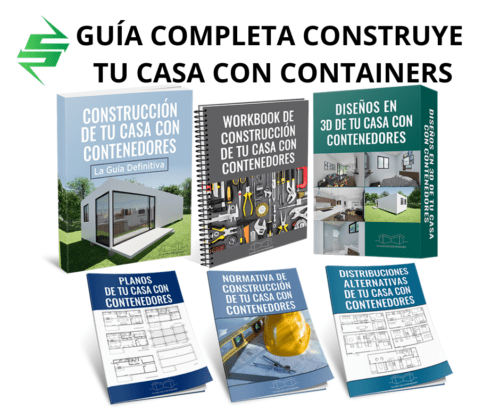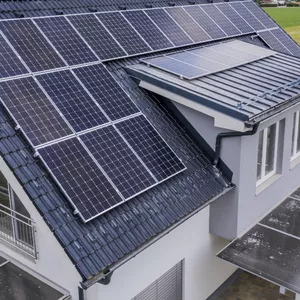We already know that the use of maritime containers for building construction is environmentally friendly. Although we’ve debunked the myth that ALL container houses are eco-friendly, there are steps you can follow to ensure yours falls into that category. In this article, we’re pleased to share some options you can consider.
We found that the two most common reasons people want to live in a container house are affordability and eco-friendliness.Read more about that here. Let’s discuss some ways you can make your containers into an eco-friendly home.
Lower the Heating
Do you really need to walk around indoors during winter wearing just shorts and a T-shirt? If you lower the thermostat and slightly reduce the hot water temperature, you could save money and cut down your carbon emissions.
Conversely, if you can tolerate a slight increase in indoor temperatures during summer, you can save a lot. Remember, a fan is cheaper to operate than an air conditioner, and a blanket is cheaper than a heating bill.
Harness Your Garden
Another great way to make your home more eco-friendly is by creating a compost heap using a compost bin or container in your garden.
Many of the everyday items we throw in the trash can be placed in a compost heap. Things like vegetable peels, fruit, tea bags, cotton clothing, and more can be recycled.
Around 30% of the waste we throw away every week could be composted and turned into fertilizer. This would be very beneficial for the environment. By using a compost pile instead of a landfill, methane gas accumulation is prevented.
If you don’t have enough space in your garden for a compost pile, you can purchase a compost container and place it in your driveway. Once the materials have decomposed, you’ll have rich compost that can be used to nourish your plants and trees.
In addition to having a compost pile, why not try growing your own food in your garden? Growing your own vegetables can save a significant amount of carbon dioxide emissions! You’ll get the satisfaction of knowing you’ve grown your own fresh food.
Unplug Your Appliances
Be smart with your electronics. Electronic devices left in standby mode, like computers, TVs, and other gadgets, waste a surprising amount of electricity. Standby mode allows these devices to turn on more quickly, activate clocks, have remote control buttons pressed, and perform other functions.
However, if you can manage a slight inconvenience in your life, consider completely powering down these devices when not in use. This is usually done by unplugging them from the socket, arranging the sockets to be controlled by switches, or plugging the devices into manually switchable power strips (which are also useful and protect your devices from power surges).
Curious about how much electricity your devices are consuming in standby mode? According to the Federal Electricity Commission (CFE), keeping appliances and other devices in standby mode consumes more than you think. According to the organization, standby appliance consumption ranges from 5% to 10% of the total electricity consumed in all households!
And if you want to measure devices in your own home, an affordable device like the following can quickly show you how much they’re using (both during operation and in standby mode).
If you’re serious about reducing your carbon footprint, consider upgrading some of your older appliances. New standards like Energy Star have greatly reduced “on” and “standby” energy usage for many devices.
Use Eco-Friendly Insulation
Both what you use to insulate your container and where you insulate it can make a big difference to the environment. Let’s start with the insulation to be used. There are a number of options available, and they differ quite a bit in terms of environmental friendliness. There are several natural options available, such as straw, cotton, hemp, and others. For example, we learned in our interview that Montessori La Milpa, a Mexican school, used straw for much of the insulation in their walls. However, depending on your climate and whether you plan to insulate the interior or exterior of your containers, condensation can seriously affect your choice.
The next issue is where to place the insulation you’ve decided will work best for your design and climate. It might be tempting to just insulate the walls, as it’s usually easier, but this isn’t a good choice for limiting heat transfer. And if you’re paying for energy to heat and cool your container, a poor heat transfer choice is a poor energy use choice. And as we know, energy use directly affects environmental friendliness.
Instead, we generally recommend that if you’re going to insulate, you should insulate the walls, roof, and underneath the container. Keep in mind that you might get away without insulating the floor if the primary heat transfer method in your climate isn’t air convection but rather solar radiation.
Insulation may not be cheap, but it usually can pay back heating and cooling bills in a few years.
Let’s Talk About Where to Insulate
Although when building with containers to save money, you might not think about insulating your walls, in the long run, this isn’t respectful to the environment and will almost certainly cost you more money.
In fact, you should insulate the walls, roof, and underneath the container; this is one way to make your container a green home.
For insulating the bottom and the walls of your containers, most times we’d opt for spray foam insulation.
This might depend on the climate and individual circumstances. For insulating the roof, we’d choose one of the eco-friendly options mentioned earlier. Insulation may not be cheap, but it can save on heating and cooling bills in a few years.
Install Photovoltaic Solar Panels
Depending on where you live, a typical solar panel system can save you an impressive amount of money on your annual electricity bill.
To get the best value from solar panels, you need a location that gets good sunlight and has little shading. A competent installation company can provide information on solar energy in your area as well as how much electricity different-sized systems might generate.
Also, keep in mind that if you want to be completely off the grid, you’ll need an expensive battery system to provide power during times of low or no sunlight. Otherwise, you’ll use your solar system during the day and the grid system at other times. Some utility companies will even buy back any excess energy you produce during the day!
Use Local Building Materials
A great way to reduce your carbon footprint is to source your building materials locally. This will be easier for some people than for others, depending on where you live and the resources available.
If you live in Canada and use oak to clad the outside of your container, fantastic! But if you live in Dubai and want to do the same, this will require you to source your materials from a long distance, greatly increasing your carbon footprint. So, using your good judgment, research local materials that are similar and that you could use instead.
If you want to take things to the next level, consider using both local and surplus building materials. Our interview with Shanti highlighted how you can obtain surplus materials in your area that can be used for your container home, as long as you have some design flexibility. There are always ongoing remodeling projects or materials damaged during shipping that can be used. While these items might not be perfect, with some creativity and slight modifications, they can still be utilized. As an added bonus, they offer significant discounts on your construction costs!
Use Efficient Bulbs
Unless you’ve been living under a rock, you’ve heard of the energy savings (and other benefits) that more efficient light bulbs can offer. The first wave of changes happened years ago when compact fluorescent lamps (CFLs) became popular. Now, LED bulbs offer even greater energy savings (and thus carbon emission savings) than compact fluorescent lamps, with fewer downsides.
LED bulbs used to be quite expensive a few years ago, but popularity and mass production have significantly lowered their price. And with energy savings of up to 85% compared to traditional incandescent bulbs that you might already be using, they’ll pay for themselves in no time. LED bulbs have a high rating and are affordable, especially if you buy a bulk package and switch them throughout your entire home.
Other Ideas for an Eco-Friendly Home
One of our favorite techniques for creating a green container home is to conduct an eco-audit room by room. Breaking down your whole home into smaller pieces the size of a room helps focus what would otherwise be an overwhelming project.
Different rooms have different use cases, occupancy levels, energy needs, etc. So, this approach allows you to tailor specific ideas to the areas where they are most applicable.
Some Additional Ideas to Save Electricity
Use water-saving showerheads and toilets Ensure your refrigerator is in the shade Use wool bedding sheets instead of polyester Try a quick shower instead of a bath to save water. Use an eco-friendly kettle or limit water boiling. Wash clothes with cold water instead of warm water.
More Techniques for Your Eco-Friendly Home
Another technique involves dividing your home not by rooms, but by building elements. For instance, you might subdivide it into walls, ceilings, and floors.
Here are some ideas to think about:
- Make sure all drafty areas in your container are sealed.
- Replace single-pane windows with double-pane windows.
- Using rugs on wooden floors can save between 4% and 6% on heating bills.
Everyday Actions
It’s important to remember that a significant part of living an eco-friendly life isn’t just the eco-friendly home itself but how you live within it. The small daily decisions you make can contribute greatly to reducing negative impacts.
Examples of this include:
- Don’t replace broken items in your home; try to repair them.
- Consider used and well-made products instead of cheaper new ones.
- For infrequently used items, consider borrowing or renting instead of buying.
Summary
Turning your standard energy-consuming home into an eco-friendly house doesn’t have to be overwhelming, and it’s not only applicable to people in certain parts of the world with specific political views. If you want to feel good while living inside your home and also feel good knowing you’re not wasting money or resources, it’s worth implementing the ideas from this article to turn your home into an eco-friendly house!
Do you have additional tips on how to make your container home environmentally friendly? Share with us in the comments section below.
 «Tu casa con contenedores» es la única guía paso a paso que existe para construir tu propia casa con containers desde cero. No importa si no tienes conocimientos sobre construcción, si pensar en ello te da dolor de cabeza, si eres constructor o trabajas en una oficina. La guía está escrita para que cualquiera pueda entenderlo. MAS INFORMACIÓN CLIC AQUÍ Construye Tu Casa con Contenedores Paso a PasoHágalo Usted Mismo
«Tu casa con contenedores» es la única guía paso a paso que existe para construir tu propia casa con containers desde cero. No importa si no tienes conocimientos sobre construcción, si pensar en ello te da dolor de cabeza, si eres constructor o trabajas en una oficina. La guía está escrita para que cualquiera pueda entenderlo. MAS INFORMACIÓN CLIC AQUÍ Construye Tu Casa con Contenedores Paso a PasoHágalo Usted Mismo MAS INFORMACIÓN CLIC AQUÍ Construye Tu Casa con Contenedores Paso a Paso
MAS INFORMACIÓN CLIC AQUÍ Construye Tu Casa con Contenedores Paso a Paso 



